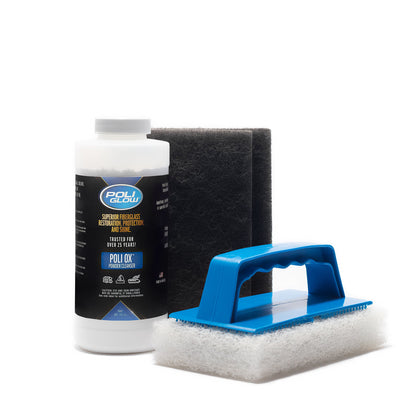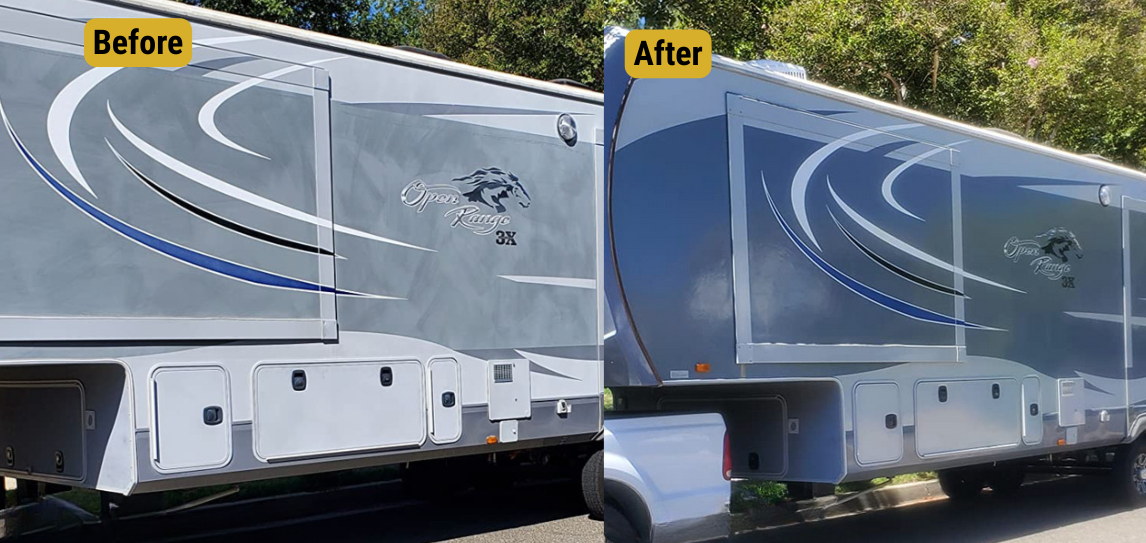
How To Remove Oxidation From a Fiberglass Boat
Time to read 7 min
No one wants a faded, rusty or chalky boat… but getting your fiberglass boat back to its original glossy shine requires some finesse.
A dull gelcoat is actually a maintenance issue that needs to be addressed with regular boat care. If the gelcoat is allowed to deteriorate over time, your boat will be susceptible to costly problems like mold, mildew, staining, rust and even rot. Prevention is key!
Luckily, you don’t have to spend your whole Saturday with the electric buffer to keep your vessel in tip-top condition. A few simple steps are all it takes to get rid of oxidation and preserve the integrity of your gelcoat.
Removing oxidation makes your boat look like new again and keeps it in the water for years to come. So stop procrastinating, read our guide to boat oxidation removal, and let’s get your lady shining!
Table of Contents
4. A Step-by-Step Guide to Removing Oxidation
5. How To Restore Your Boat’s Shine and Gloss
What Is Oxidation?
Brand-new fiberglass boats have a slick, high-gloss finish. This comes from the gelcoat, a protective layer that covers the fiberglass to shield it from moisture, heat and UV radiation.
Without proper maintenance, the gelcoat breaks down and degrades over time. It becomes more porous and no longer protects the fiberglass layers underneath. This process, called “oxidation”, leads to faded paint, staining, mold, hard-to-clean dirt, and weathering… everything you don’t want!
The solution is to loosen and remove the damage to uncover the surface colors of your boat, then seal it to prevent future damage.
In the past, the primary way to accomplish this was to remove a layer of gelcoat using an electric buffer and a polishing compound. This would be sealed with boat wax to protect the rig for up to a year.
While heavy buffers and compounds work well when used correctly, the process can be a hassle and requires frequent upkeep. So it’s no surprise that you see so many weather-beaten boats sitting in the marina!
This harsh method of boat maintenance also removes a layer of gelcoat with every buffing, which means that eventually your gelcoat will be completely sanded away.
How Poli Ox® Can Help
Removing oxidation doesn’t have to be a (literal) grind. Here at Poli Glow®, we’re all about simplifying boat maintenance so you can spend less time in the dry dock and more time out on the water! That’s why we innovated a system for easily restoring– and maintaining– the glossy sheen you want.
Poli Ox® is a specialized boat cleaner that uses oxalic acid to remove moderate to heavy oxidation from your gelcoat. The concentrated formula requires much less force to be effective than a traditional polishing compound, which means it keeps your gelcoat intact for longer.
No buffer needed! Simply use Poli Ox® with our non-abrasive scrubber and ultra-fine sanding pad to scrub away dirt, scum, black streaks, old wax, mildew and other nasties that have accumulated on your boat. All of these products can be found in our Poli Ox® Boat Oxidation Removal Kit, which has everything you need to remove oxidation from your fiberglass boat.
Finish with our proprietary boat polish Poli Glow® to preserve the gelcoat and guard against further damage. This hard, shiny coating keeps your gelcoat in great condition for up to six years with regular maintenance. It’s that easy!

Preparing To Remove Oxidation
Removing boat oxidation is a big job– that’s probably why you’ve been putting it off! The good news is that correctly prepping your boat and using the right products can save you a TON of time, stress and elbow grease. Here’s how to get set up.
Haul `Er Out
Okay, you knew this was coming. In order to remove oxidation from your fiberglass boat, she needs to be out of the water so you can access the hull. Pick a good-weather day (that means no rain, high humidity or temperature extremes), move your vessel onto a trailer and get to work. Make sure the trailer is on a level surface where you can comfortably reach every part of your boat.
Batten Down the Hatches
Take a few minutes to remove loose items and personal gear from the boat. Secure any loose ropes or cables and cover your electronic systems.
This is an ideal time for an all-over boat inspection. Walk around your boat and observe the hull, deck and upper areas. Are there any cracks, blisters, de-lamination or soft spots? Make a note of damaged areas and maintenance/repair tasks that need to be addressed.
Gather Your Supplies
To remove oxidation, you’ll need a boat-specific cleaner, disposable gloves, a chemical oxidation remover such as Poli Ox® , a non-abrasive scrubber, and a sanding pad with a moderate level of abrasion.
You’ll use the non-abrasive scrubber for all-over polishing, and the sanding pad to work on tough spots. A hose is helpful for rinsing your boat, but you can also use buckets of fresh water if you don’t have access to a hose.
Wash Your Boat
Before attacking the heavier stains and oxidation, use a marine cleaner like Poli Wash® and a microfiber cloth to gently remove surface-level dirt and grime. To prep your boat, mix 1-2 ounces of Poli Wash® into a 5-gallon bucket of water. (If you’re using a different cleaner, follow the instructions on the product label).
Wash the surfaces of your hull with the cloth, using circular motions and working from top to bottom. It’s okay if some stains don’t come off– the oxidation remover will take care of that.
Rinse the boat thoroughly with clean, fresh water. The marine cleaner should not be allowed to dry on the surface of your boat.
A Step-by-Step Guide to Removing Boat Oxidation
So your boat is clean and resting on a stable surface. Time to tackle that oxidation! For the purposes of this guide, we’ll be using our concentrated oxidation remover Poli Ox®.
It uses a chemical formulation to break down the chalky oxidized layer on your boat, which means no electric buffer is required. Our Poli Ox® Boat Oxidation Removal Kit comes with everything you need to get rid of stubborn stains.
- Protect your hands with disposable gloves.
- Sprinkle Poli Ox® onto the non-abrasive scrub pad. Gently rub Poli Ox® into the pad to prevent spillage.
- Starting from the top of the hull and working downwards, wet the gelcoat and polish in circular motions with the scrub pad.
- For deep stains and areas of heavier oxidation, apply Poli Ox® to the Ultra-Fine Sanding Pad and scrub until the oxidation is removed.
- Continue this process with the rest of the hull.
- Rinse with fresh water and inspect the condition of your boat. The surface should look uniformly dull without color changes, blotches or stains. (The colors may still look faded, but don’t worry– we’ll go over that in the next section.) Repeat Steps 2-5 as needed to achieve this result.

How To Restore Your Boat's Shine and Gloss
Congratulations on getting that damaged layer off your boat! It’s probably looking a million times better already… but you may notice that it has a “bleached” appearance, like it was left to bake in the California sun. Don’t stress, this is completely normal!
In order to restore a shiny, high-gloss look and protect your boat from future damage, you need to seal in the healthy gelcoat with a marine polish. Otherwise, all your hard work of removing oxidation will quickly be lost.
Our flagship product Poli Glow® is a mariner favorite for its ability to give boats a brilliant, long-lasting shiny finish. It penetrates into the gelcoat after you remove the oxidized layer to seal the boat’s original colors and defend against future oxidation. It also contains UV inhibitors that protect against sun damage!
To apply Poli Glow®, simply moisten the included applicator mitt and smooth the product onto the hull using vertical or horizontal strokes. Apply thin layers and allow each coat to dry thoroughly between applications.
Let your boat cure in a dry place for 48 hours, then get ready for the compliments to roll in!
Maintenance Tips To Prevent Oxidation
Serious boat owners know that upkeep is an ongoing project, not a one-off job. Having a regular boat maintenance schedule saves you both time and money, as you won’t have to shell out for pricey restoration work that could have been prevented.
A gelcoat treated with Poli Glow® will oxidize much more slowly than one treated with traditional boat waxes. If properly maintained, Poli Glow® can last five to six years between full restoration jobs. Here’s how to keep your boat looking and performing its best.
Plan to get your boat onto a trailer at least once a year. Check all the surfaces for maintenance needs and take care of small issues before they grow into huge hassles. Wash your boat with Poli Wash® , use Poli Ox® to treat any oxidation spots, then seal it with 3-4 coats of Poli Glow® to maintain your glossy shine.
Bear in mind that where you live determines how often you should apply maintenance coats. Boats in tropical climates require more frequent maintenance than boats in temperate ones. Keep an eye on your boat’s condition and adjust your timetable if it starts looking weathered or dull.
How To Remove Oxidation in 30 Seconds
In case you didn’t read the full guide, here’s the CliffsNotes version for how to remove oxidation from your fiberglass boat:
- Faded, chalky, or stained hulls are caused by the gelcoat breaking down in a process called “oxidation”.
- Removing the oxidized layer is essential for preventing damage to your boat.
- Pick the right weather and location to remove oxidation.
- Wash your boat and remove any loose items before tackling oxidation.
- Use a targeted, boat-specific cleaner like Poli Ox® to treat oxidation spots without electric buffers or abrasive compounds that strip your gelcoat.
- Seal the gelcoat with a protective coating to prevent future damage and restore glossy shine. Poli Glow®’s wipe-on polish makes this easy and low-maintenance.






